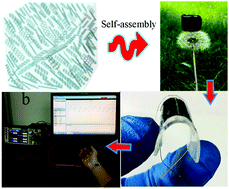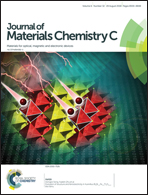Graphene-based cellular materials with extremely low density and high pressure sensitivity based on self-assembled graphene oxide liquid crystals†
Abstract
Three-dimensional (3D) graphene materials with high elasticity and low density are a prerequisite for achieving high sensitivity in flexible strain sensors. However, conventional 3D graphene materials with extremely low density often struggle to attain excellent mechanical resilience. Here, a material synthesis strategy, including self-assembly and annealing steps, is developed to fabricate a novel 3D cellular material, graphene oxide liquid crystals–konjac glucomannan, with high elasticity and low density for possible application in highly sensitive flexible strain sensors. The novel introduction of biomass, konjac glucomannan, largely enhances the elasticity of the 3D cellular structure, endowing the resulting material with a high Young's modulus of 10.3 kPa at a low density of 1.56 mg cm−3, and excellent mechanical durability for >1000 cycles. The assembled flexible strain sensor based on cellular material exhibits a particularly high sensitivity of 0.28 kPa−1, a fast response of 40 ms (rising time) and excellent cycling stability. Importantly, practical application of the sensitive strain sensor has been realized through monitoring a variety of human motion in real time, suggesting the creation of a novel candidate for applications in wearable medical devices and electronic skin.



 Please wait while we load your content...
Please wait while we load your content...